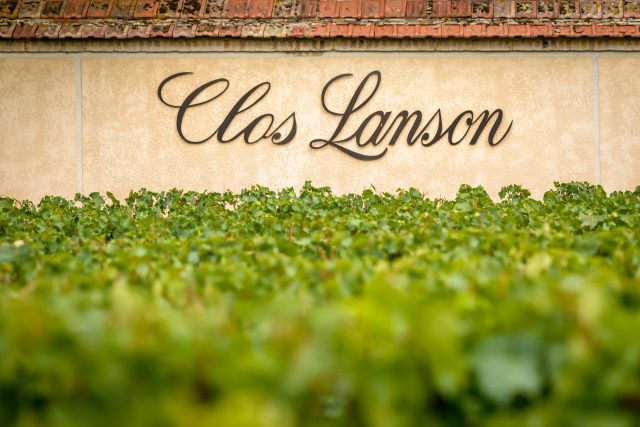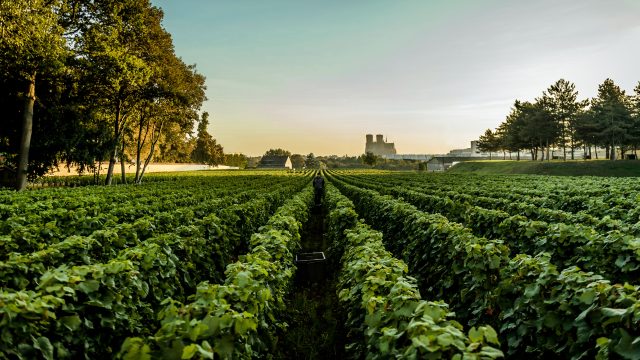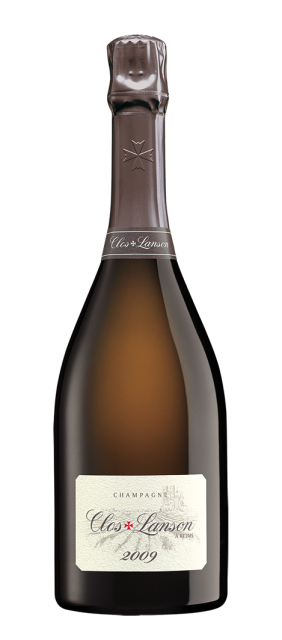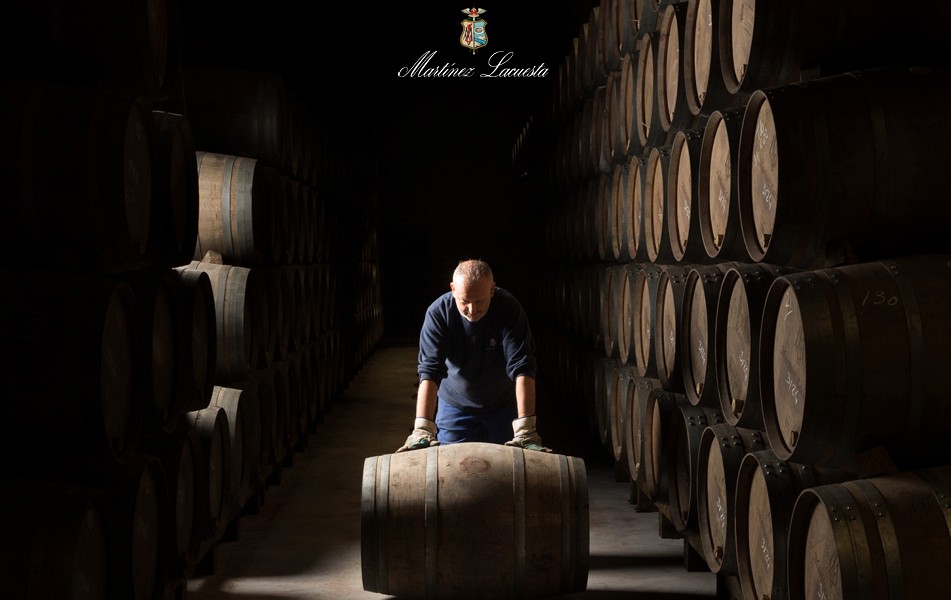Clos Lanson’s first release on la place de Bordeaux
A year on from Maison Philipponnat’s bringing of Clos des Goisses to la place de Bordeaux, Lanson follows suit with an inaugural release of its historic monopole Clos Lanson on la place. Our correspondent Colin Hay speaks to Lanson’s chargé d’affaires Enguerrand Baijot and chef de Cave Hervé Dantan about the new release.

The wine will be released on the 4th of October. Interestingly, it is brought to la place by the same courtier, Timothée Moreau of Bureau des Grands Vins, who brought Clos des Goisses to la place last September. He is becoming something of a specialist in the leading micro-cuvée Champagne of the region. The tiny quantities (the release is around 5000 bottles of the 7000 produced after a strict selection in the vineyard) will be distributed by just five négociants (Joanne Rare Wines; Twins; Ulysse Cazzabone; Maison Ginestet; and CVBG) in all countries other than the US (where distribution remains direct).
Clos Lanson is utterly singular – a tiny walled grand cru vineyard nestling between the apartment blocks of the city of Reims with a direct view of the cathedral itself. The high-walled Clos is almost exactly 1 hectare in size and it dates from the eighteenth century when it was still in the countryside. The wine has the wonderful singularity of the being aged in Lanson’s cellar immediately beneath the neat rows of vines themselves. It is a Champagnois jewel and it seems very fitting that it would join Clos des Goisses on la place. It is also grown organically and has the additional distinction of being entirely vinified and aged in small oak barrels, with the oak being sourced from the forest of Argonne (around 100 kilometres to the east of Reims).
I was lucky enough to board again the train for Reims where I visited the Clos and the chai below, tasted the first three vintages of this exceptional wine and talked to Enguerrand Baijot (EB), Lanson’s Chargé d’affaires, and Hervé Dantan (HD), Lanson’s Chef de Cave, about the wine itself and the reasons for bringing it to la place today.
What makes Clos Lanson so special?
HD: My answer may not be very original, but it expresses profoundly what I believe. Crucially, this is a Clos (a walled-vineyard). Clos are rare in Champagne. In my view there are essentially three criteria for being seen as a true Clos in Champagne: the history, the place itself and the wine it gives rise to.
In terms of history, it would be difficult to think of another Clos with such a history. It is a parcel in the very centre of the town, close to the Cathedral. It has witnessed many things and could recount many tales. Even in its relatively recent history, it could tell us about the two world wars, about being picked by the women of the town as their men fought on the front, about the bombardments and the bombings. It could tell us too about urbanisation and being encircled by the city as it grew – a time during which the vineyard was progressively reduced in size from around 12 hectares to just the 1 hectare of the Clos itself. The vineyard has a direct view of the Cathedral itself – so central to the history of Reims and to, indeed, France. It is perhaps not strictly speaking a sacred place, but when one is in the midst of the vineyard one senses being in the presence of the Cathedral and of sharing in its history.
In terms of place, the Clos has the same singularity. Climatologically, it is always 2 or 3 degrees warmer than the nearest vineyards 2 kilometres or so away. It is very much a microclimate. It is hotter and the vegetative cycle is different, above all more precocious. Yet, paradoxically, the growing season is often longer and that allows the vineyard to achieve an exceptional, even magical, degree of maturation. The particularity of the place, this terroir, produces grapes which always have a high degree of maturity, allowing us to make a single vintage each year – even in the most challenging of vintages. It also has a wonderful natural acidity from the chalk/limestone soil. From that comes the very personality of the wine – a personality essentially linked to place. It is pure Chardonnay, of course, combining all we know of it: citrus notes, white fruit and freshness.
The wine recounts the place from which it comes; it expresses its terroir. Its aromatic generosity comes from the microclimate that we know – always hot, always generous. In the mouth the wines has a rich, voluptuous and distinctive velvety (velouté) character. And as it unfolds over the palate it’s as if it traverses the parcel and returns to the soil, with its elemental minerality, length, freshness and natural salinity. It returns always to the chalk on the finish. So the very personality of the wine comes from its place – in Reims, this place. We have lots of Chardonnay at Lanson – but the Chardonnay of the Clos is different in kind from all our other Chardonnays. It is the parcel that best expresses its terroir and, indeed, the vintage. It is a wonderful complicity between freshness and generosity.
What motivated your decision to release Clos Lanson on la place de Bordeaux now?
EB: Very simply, our idea is to be sold by some of the most respected négociants on the la place de Bordeaux and, in so doing, to make Clos Lanson available to more customers and wine-lovers. We also hope to strengthen the image and reputation of Lanson through its association with so many of the world’s leading wines including, of course, those of Bordeaux itself via la place.
In terms of the timing of the release it is crucial to us that when the wine becomes available it is perfectly ready to be drunk by the consumer. Our philosophy is that all of our wines need to be drinkable on release. With the wine being disgorged in May of this year, we could not release before October. It’s a good moment to release too, but the principal reason it to ensure that the wine is ready.
Timing is crucial. Clos Lanson is a rare micro-cuvée whose microclimate ensures that it can be made every year. As such, we aim to release a new vintage each and every year. This is the introduction. It has to be perfect.
Has the release posed any particular difficulties for you (for instance, with existing distributors)?
EB: It has to be a ‘win-win’ situation. For the brand; for the négociants; and for our domestic partners too. Bringing Clos Lanson to la place has reinforced, and is part of, our more general value strategy for Lanson. We will keep our local partners focussed on the new prestige cuvée, Noble champagne (we should talk about that in more detail, perhaps on another occasion). That is to be launched at the same time, in October, initially in some of our most crucial markets (the UK, the US, Italy, Switzerland and Japan). At the high end of the market, then, our existing distributors will now be focussed on Noble alone. That is good for the brand, good for the négociants and good for our domestic partners.
So, quite honestly, releasing Clos Lanson on la place has not generated a single difficulty with our existing distributors. They understand the logic and the project and they support both. La place is, we feel, the best way to sell and to distribute Clos Lanson and our existing domestic partners are the best route through which to sell Noble. That works for everyone.
In addition, Clos Lanson has existed only since 2006. The 2007 is the current release, sold through our existing network of distributors. And, to date, there has only been one prior release – the inaugural 2006 vintage. The quantities are also very small. So this does not represent a massive shift to a long-standing distribution system. That has clearly helped too. We wondered how they would react; we explained it to them; and they understood – most of them, in fact, congratulated us.
Partner Content

Do you expect to see more champagne houses joining you on la place … and what kind of champagnes are likely to work best in your view?
EB: Again, my answer is a very simple one. Will there be a proliferation of Champagne houses on la place? Maybe – we’ll see! However, and whatever happens, we will forever be the first to sell globally our rarest cuvée through la place. And in this, as in so many things, it is all about being the first!
It is of course true that Clos des Goisses arrived on the la place a year before us, but with lots of restrictions (la place does not have access to the global market even today). There are very few restrictions when it comes to Clos Lanson and in that respect we are the first to give an essentially global distribution to la place. We are fortunate to be able to do so as it maximises the likelihood that the strategy will be a success.
As to the kinds of champagnes likely to work best on la place … well, they need to be of limited production, they need to be rare and they need to be genuinely exceptional. Ideally, too, in our view, it is best if there is limited to no domestic presence already of the cuvée so that you are not taking business away from your existing domestic partners. Also, price integrity needs to be respected in all markets. This is a key element that is perhaps not sufficiently well appreciated.
If these three conditions are met, not only can a release on la place work but is likely to work very well.
How is the 2022 vintage looking?
HD: It’s looking good! It’s of course too early to say definitively and I am not the kind of person to declare, especially at this stage, a vintage to be a great vintage before the wine is made. But, speaking personally, I’ve never seen a harvest like it. It is perhaps most like 2018: a vintage and a growing season beyond the normal, unprecedented even. First, there have been absolutely no problems at all with the health of the vines and there is an incredible colour and intensity to the fruit we are bringing in. From the Clos we have golden Chardonnay of the very highest quality. This year there is no need for Photoshop to have pictures of perfect fruit!
Visually, but also on paper, this is a vintage of one’s dreams – in terms of maturity and potential alcohol. The fruit has all the characteristics of a sunshine vintage. Indeed, we have never had a vintage so sunny in Champagne than 2022. Each month of the year broke records for hours of sunshine. We broke no records for heat. We broke no records for lack of rain. But we broke every record for sunshine. And that means that we have had no sanitary problems in the vineyard, no botrytis and, of course, super levels of maturity. Of course, we also have comparatively low levels of acidity – as in other sunny vintages likes 2015, 2018, 2019 and 2020. But in the Clos, especially, we have the very best terroir to compensate for that. Overall, then, we have the profile of a vintage that is, good, very good or even exceptional.
But the wine is still to be made and time will tell. At minimum these should be very good.
In terms of the characteristics of the vintage, there is a resemblance to 1959 – in terms of maturity and potential alcohol. This year we have picked parcels at 12.5 degrees, just as in 1959. In the 21st century the vintages ending it ‘2’ seem to have fared well: 2002, 2012 …. 2022. It is promising, certainly! In comparison to the rest of the France we have been relatively lucky – not much rain, but without immense hydric stress at any point. Even now, after the harvest, the vines remains in fine form – their foliage remains green.

Tasting notes
- Clos Lanson 2009 (100% Chardonnay; from Lanson’s historic walled vineyard within the city of Reims itself and with a direct view of the Cathedral; a wonderful pure calcaire terroir gives this natural freshness; no malolactic fermentation to retain the freshness; this has aged 12 years on the lees in the cellar directly below the vineyard; disgorged May 2022; 3g/l dosage; 7454 individually-numbered bottles produced, with around 5000 released on la place; 12.5% alcohol; tasted three times with consistent notes, most recently with Enguerrand Baijot and Hervé Dantan in Lanson’s chai beneath the vines themselves just over two weeks before its release on la place). A truly fabulous and singular wine that was immensely promising when I first tasted it just 2 months after its disgorgement, but that has improved each time I have tasted it as it has relaxed and revealed more of its identity. Bright, energetic and radiantly expressively on the nose, with a fabulously complex aromatic profile, both fresh and rich at the same time. There are fifty shades of citrus here – the most striking being tangerine zest and oil; pear, green apple skin; a touch of spice that builds in the glass; confit citrus notes, a little pink grapefruit skin and more exotic notes of pineapple and passionflower. There is jasmine and honeysuckle too, toasted brioche, almond and frangipane and a gentle hint of white truffle. Brilliantly tense and pure in this warm and sunny vintage, the pure chalk helping this to retain the signature poise and freshness of its terroir. As with the other vintages tasted, there is a palpable sense of structural evolution in the mouth, as the natural acidity and saline minerality of the terroir draws the wine out over the palate, reining in the rich generosity of the attack. A gloriously velvety mouthfeel too. Quite superb. 98.
- Clos Lanson 2007 (100% Chardonnay; no malolactic fermentation; long aging on the lees in the cellar directly below the vineyard; disgorged July 2016; 3g/l dosage; 7390 bottles produced, all numbered; 12.5% alcohol; tasted with Enguerrand Baijot and Hervé Dantan in Lanson’s chai beneath the vines themselves in September 2022). A wine of great purity, authenticity and precision. The saline minerality is more immediately evident on the nose which is, in turn, more dominated by the citrus elements than the other two vintages tasted here. White peach rather than pear, white truffle too, trompette de la mort, mandarin, confit melon, citron pressé and a little hint of nougat and honey. On the palate, this is a little less rich than the other two vintages, a little tighter and, again, more dominated by the citrus elements. But it is wonderfully pure, precise and focussed. With aeration, a touch of cinnamon appears, a little vanilla and even liquorice. Bright, lively and crunchy, this is impressively rich and voluptuous for the vintage but the least substantial of the three vintages tasted, as you’d expect. A brilliant expression of both the vintage and of this singular terroir. 96.
- Clos Lanson 2006 (100% Chardonnay; no malolactic fermentation; long aging on the lees in the cellar directly below the vineyard; disgorged December 2014; 3 g/l dosage; 7870 bottles produced, all numbered; 12.5% alcohol; tasted with Enguerrand Baijot and Hervé Dantan in Lanson’s chai beneath the vines themselves in September 2022). The first vintage of Clos Lanson to be bottled separately and somewhat different in personality. Immediately spicy, rich and full on the nose, though with the same bright brilliance and verticality of the more recent vintages. There is no truffle note at present and a more pronounced sense of spice and herbs in combination, enrobing the pear and apple fruit; this is nuttier too, a little richer and with more of a nougat and praline component. Broad, ample and bold on the attack with that characteristic velvet mouthfeel, this is once again very structured on the palate, with the citrus-charged acidity pinching the wine in mid-palate and drawing it out in the mouth towards a long and tapering finish. I love the combination of cracked white pepper, orange zest and grapefruit flesh that is left in the mouth. Exquisitely tense. 95.
Related news
Castel Group leadership coup escalates
For the twelfth day of Christmas...
Zuccardi Valle de Uco: textured, unique and revolutionary wines




